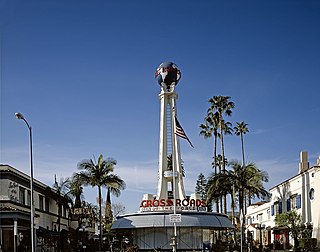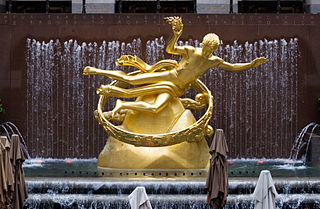
Miracle Mile is a neighborhood in the city of Los Angeles, California.

The Hollywood Palladium is a theater located at 6215 Sunset Boulevard in the Hollywood neighborhood of Los Angeles, California, United States. It was built in a Streamline Moderne, Art Deco style and includes an 11,200-square-foot (1,040 m2) dance floor including a mezzanine and a floor level with room for up to 4,000 people. The theater was listed on the National Register of Historic Places in 2016. The Palladium was designated Los Angeles Historic Cultural Monument No. 1130 on September 28, 2016.
The history of Santa Monica, California covers the significant events and movements in Santa Monica's past.

Streamline Moderne is an international style of Art Deco architecture and design that emerged in the 1930s. Inspired by aerodynamic design, it emphasized curving forms, long horizontal lines, and sometimes nautical elements. In industrial design, it was used in railroad locomotives, telephones, buses, appliances, and other devices to give the impression of sleekness and modernity.

Crossroads of the World is an open-air mall on Sunset Boulevard and Las Palmas in Los Angeles. The mall features a central building designed to resemble an ocean liner surrounded by a small village of cottage-style bungalows. It was designed by Robert V. Derrah, built in 1936, and has been called America's first outdoor shopping mall.

The Pellissier Building and adjoining Wiltern Theatre is a 12-story, 155-foot (47 m) Art Deco landmark at the corner of Wilshire Boulevard and Western Avenue in Los Angeles, California. The entire complex is commonly referred to as the Wiltern Center. Clad in a blue-green glazed architectural terra-cotta tile and situated diagonal to the street corner, the complex is considered one of the finest examples of Art Deco architecture in the United States. The Wiltern building is owned privately, and the Wiltern Theatre is operated by Live Nation's Los Angeles division.

Ocean Drive is a major thoroughfare in the South Beach neighborhood of Miami Beach, Florida.
Ahmad Adaya (1927–2006) was an American real estate tycoon and philanthropist who was the founding partner of a California real estate company IDS Real Estate Group. He was known for establishing the New Horizon School for Muslim religious education in southern California.

The Miami Beach Architectural District is a U.S. historic district located in the South Beach neighborhood of Miami Beach, Florida. The area is well known as the district where Italian fashion designer Gianni Versace lived and was assassinated by Andrew Cunanan, in a mansion on Ocean Drive. It is bounded by the Atlantic Ocean to the east, Sixth Street to the south, Alton Road to the west and the Collins Canal and Dade Boulevard to the north. It contains 960 historic buildings.
Claud W. Beelman, sometimes known as Claude Beelman, was an American architect who designed many examples of Beaux-Arts, Art Deco, and Streamline Moderne style buildings. Many of his buildings are listed on the National Register of Historic Places.

The Hotel Casa del Mar is a historic luxury hotel located on the beach in Santa Monica, California. It is owned and operated by the Edward Thomas Collection of Hotels.

Charmont Apartments is an historic five-story apartment building in Santa Monica, California which was built in 1928. Designed by architect Max Maltzman with elements of both the Mission Revival-Spanish Colonial Revival style and the Art Deco style, the Charmont was a luxurious high-rise when it was built. The blending of Spanish Colonial Revival and Art Deco elements was popular style in the 1920s and is sometimes known as "Med-Deco." The main entrance is located in a walled courtyard that features a two-tiered fountain with an intricate Moorish-patterned backsplash in polychrome tile.

The Sunset Tower Hotel, previously known as The St. James's Club and The Argyle, is a historic building and hotel located on the Sunset Strip in West Hollywood, California, United States. Designed in 1929 by architect Leland A. Bryant, opened in 1931, it is considered one of the finest examples of Art Deco architecture in the Los Angeles area. In its early years, it was the residence of many Hollywood celebrities, including John Wayne and Howard Hughes. After a period of decline in the early 1980s, the building was renovated and has been operated as a luxury hotel under the names The St. James's Club, The Argyle, and most recently the Sunset Tower Hotel. The building was added to the National Register of Historic Places in 1980.

Koning Eizenberg Architecture (KEA) is an architecture firm located in Santa Monica, California established in 1981. The firm is recognized for a range of project types including: adaptive reuse of historic buildings, educational facilities, community places, and housing. Principals Hank Koning, Julie Eizenberg, Brian Lane, and Nathan Bishop work collaboratively with developers, cities and not-for-profit clients. Their work has been published extensively both in the US and abroad, and has earned over 200 awards for design, sustainability and historic preservation.

The Fairmont Miramar Hotel & Bungalows is a historic five-star hotel located near the beach in Santa Monica, California, not far from the Santa Monica Pier. The property was originally a private estate, built in 1889. It was converted to a hotel in 1921.

The Art Deco style, which originated in France just before World War I, had an important impact on architecture and design in the United States in the 1920s and 1930s. The most notable examples are the skyscrapers of New York City, including the Empire State Building, Chrysler Building, and Rockefeller Center. It combined modern aesthetics, fine craftsmanship, and expensive materials, and became the symbol of luxury and modernity. While rarely used in residences, it was frequently used for office buildings, government buildings, train stations, movie theaters, diners and department stores. It also was frequently used in furniture, and in the design of automobiles, ocean liners, and everyday objects such as toasters and radio sets.

Shangri-La is a Streamline Moderne mansion in Denver, Colorado, United States. Commissioned by Denver movie theater magnate Harry E. Huffman and designed by architect Raymond Harry Ervin, it is a replica of the fictional monastery featured in the 1937 film Lost Horizon. Built on a 5-acre (2.0 ha) tract of land in 1937–38, it was occupied by Huffman and his wife until 1969. Beginning in 1962, the west lawn was subdivided and populated with additional upscale housing, including Cableland, and the circular drive was remapped as Shangri La Drive. The current owners of the house are A. Barry and Arlene Hirschfeld.
Charles F. Plummer (1879–1939) was an American architect, known for his work in and around Los Angeles, California. Many of his works have been listed as Los Angeles Historic-Cultural Monuments (LAHCM), in the National Register of Historic Places (NRHP), or both.

















